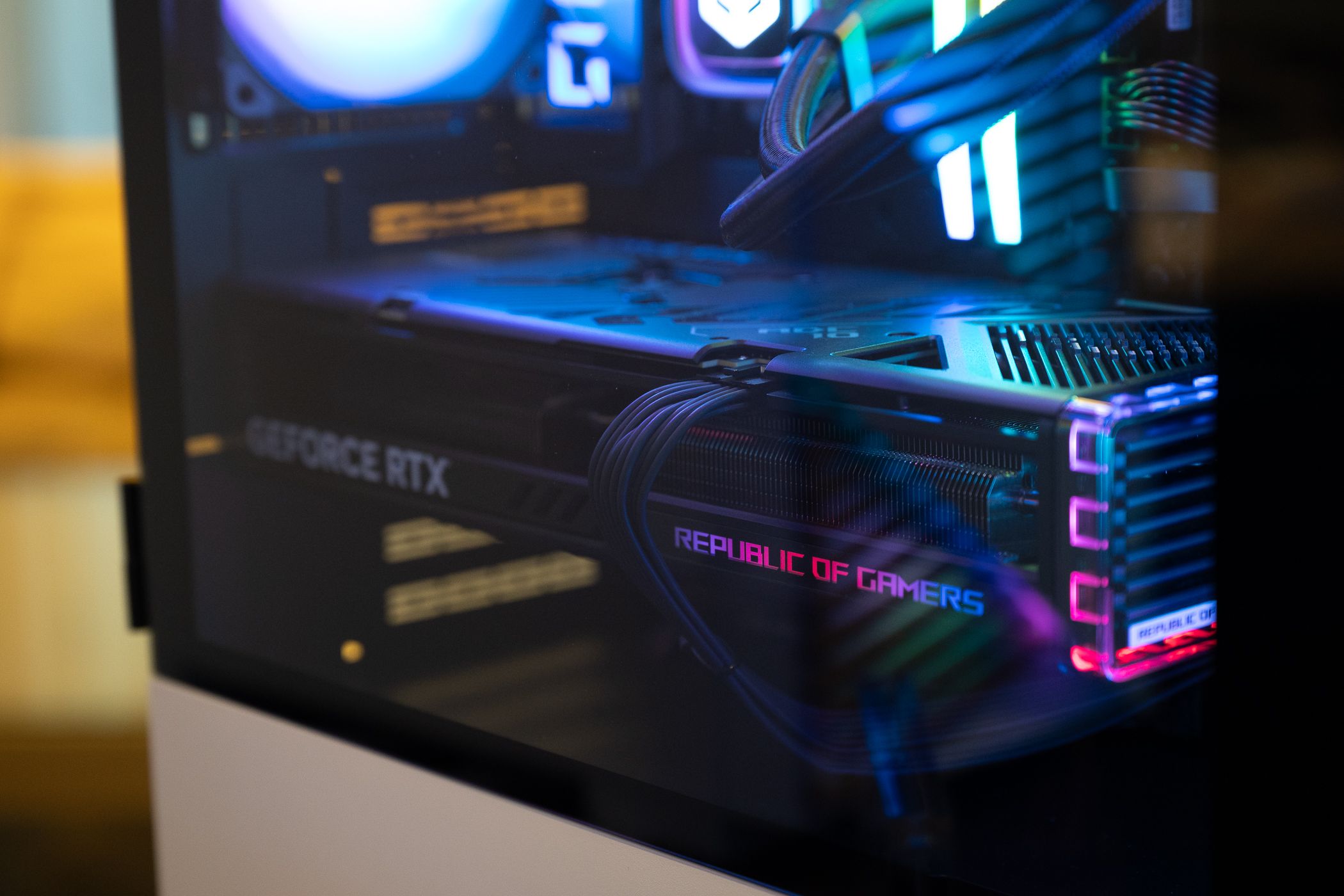
Ensuring Your PC Is Prepared: A Guide to Assessing Compatibility with New Graphics Cards

Ensuring Your PC Is Prepared: A Guide to Assessing Compatibility with New Graphics Cards
Quick Links
- Can Your PSU Power the GPU?
- Check Your PSU’s Power Connector Type
- Check Your Motherboard’s PCIe Slot Version
- Does Your PC Have Enough Space for the GPU?
- Check for Other Potential Bottlenecks
- Will the GPU Meet Your Needs?
Key Takeaways
- Calculate the power requirements for your GPU and other PC components and ensure your PSU can meet them. If the PSU has a low wattage rating, you’ll need to upgrade it.
- Ensure that your computer can accommodate the new GPU and that there’ll be sufficient airflow around it to help it operate within normal operating temperatures.
When shopping for a new GPU, you must make sure that it’s compatible with your system. You should check if the PSU can handle its power requirements and assess its compatibility with your motherboard and other components. Here are some tips to help you check whether your PC can handle your next GPU.
Can Your PSU Power the GPU?
The PSU converts incoming AC power to regulated DC power and supplies it to your PC components. When installing a new hardware component, you must ensure that the PSU can handle the additional power demand . Insufficient power supply can cause performance issues or prevent your system from even detecting the card.
For this reason, it’s important to confirm that the PSU can handle the power demand of the GPU you intend to install. To check that, go to the manufacturer’s website to check the GPU’s power demand (in watts). Then, calculate the total power needs of all components installed in your device, including RAM, SSD, and other peripherals.
Add the total power requirement of PC components and subtract it from the PSU wattage. If the net power demand exceeds the PSU wattage, you’ll need to upgrade your power supply unit. Even if it barely meets the demand, consider upgrading the PSU to get the best performance from your GPU.
Check Your PSU’s Power Connector Type
Aside from meeting the power demand, your PSU must support the right connector type to power the GPU . The power connector can be 6-pin, 8-pin, or 12-pin. A cable with a 6-pin connector can supply 75W of power, while an 8-pin connector supplies up to 150W. Additionally, the motherboard provides around 75W of power from the PCIe x16 slot.
The connectors are typically arranged in two rows. The 6-pin connector consists of six pins arranged in two rows of three pins, while the 8-pin (which is commonly in two parts: 6+2) features eight pins arranged in two rows, each containing four pins. Since the 8-pin connector comes in two parts, you can also use it as a 6-pin connector if needed.
So, choose a connector based on what your PSU supports and can power your GPU. Otherwise, you may have difficulty connecting the graphics card or getting stable power.
Check Your Motherboard’s PCIe Slot Version
For your processor to work well with your GPU, it must ideally support the same or higher PCIe generation, also known as PCIe revision. Each PCIe generation has different data transfer rates. So, if your graphics card supports higher PCI Express generation, but your processor only supports lower revision, the data transfer rate will be limited.
To prevent this, go to the website of your laptop or motherboard manufacturer and note down the PCIe generation of your processor. Then, visit the website of your GPU manufacturer and note its PCI Express Configuration or PCI Express Generation.That said, this isn’t the most critical consideration, and there’s more nuance to PCIe versions and GPUs than I have room for here. Instead, I strongly encourage you to read The PCIe Version Doesn’t Matter for Graphics Cards Like You Think which explains the finer considerations in detail.
Does Your PC Have Enough Space for the GPU?

Justin Duino / How-To Geek
Aside from the previously mentioned factors that are important to check before purchasing a new GPU, you should ensure that your PC has enough space to accommodate it. Check the dimensions of the graphics card on the manufacturer’s website and measure the space in your computer case where you intend to install it. Then, confirm that the GPU can fit properly.
Also, ensure that you install the GPU in a location where it receives sufficient airflow to operate within normal temperature ranges. If there’s any congestion around it, there may not be enough airflow to cool it down properly. That can cause it to overheat and impede the performance of your card. The GPU cooler type your card has will influence what counts as sufficient airflow.
Overheating can degrade the performance of your GPU and that of nearby components, including but not limited to the CPU, RAM, and motherboard. Thus, by ensuring that there’s ample airflow where you plan to install the GPU, you can maximize the performance and longevity of your valuable GPU.
Check for Other Potential Bottlenecks
Bottlenecks occur when the performance of one PC component is limited by another component installed on your device. For example, purchasing an advanced GPU while having an old and low-end processor can cause a bottleneck that could compromise the GPU’s performance.
Pinpointing bottlenecks in your system’s components is pretty straightforward, but predicting potential bottlenecks can be more challenging. One useful approach is to use a bottleneck calculator, which can guess the compatibility between your GPU and other hardware components. However, note that bottleneck calculators aren’t always reliable.
So, get professional advice, and if a particular component is expected to affect GPU performance, you may have to upgrade it to get the best performance from your GPU.
Will the GPU Meet Your Needs?
Lastly, keep in mind the intended use of the GPU you plan to purchase . If it’s primarily for gaming, make sure it offers the power needed for your desired gaming experience. For high-performance gaming, the AMD Radeon RX 6750 XT could be a good choice. Likewise, if you’re on a budget, the AMD Radeon RX 6600 might be a good choice.
The above tips can help you check the compatibility of the GPU you plan to buy with your system. Knowing this in advance will save you from potential replacement headaches and protect you from investing in a high-end graphics card that your other system components may not support. So, you don’t lose out on potential computing power.
Also read:
- 2024 Approved Breaking Barriers in Advertising Animating for Maximum ROI on FB
- 2024 Approved Efficiently Control Your iPhone's View Size
- Future of Wireless Audio: A Detailed Comparison of Apple's New AirPods Offerings Explained | ZDNET
- In 2024, Talking Texts A Beginner's Guide to Animated Instagram Captions
- In 2024, Topline Numbers PewDiePie's Yearly Income
- Top-Rated iPhone 14 Pro & Pro Max Protective Cases - ZDNET's Picks
- Top-Rated Protectors: The Ultimate Guide to iPhone 14 Pro & Pro Max Cases - TechReviews
- Uber Introduces Carbon Footprint Tracking Feature, Showcasing Your CO2 Reduction Achievements
- Uncovering the Massive Green Threat to Apples | Breaking News on ZDNet
- Title: Ensuring Your PC Is Prepared: A Guide to Assessing Compatibility with New Graphics Cards
- Author: George
- Created at : 2024-12-16 17:00:53
- Updated at : 2024-12-21 22:46:17
- Link: https://hardware-tips.techidaily.com/ensuring-your-pc-is-prepared-a-guide-to-assessing-compatibility-with-new-graphics-cards/
- License: This work is licensed under CC BY-NC-SA 4.0.